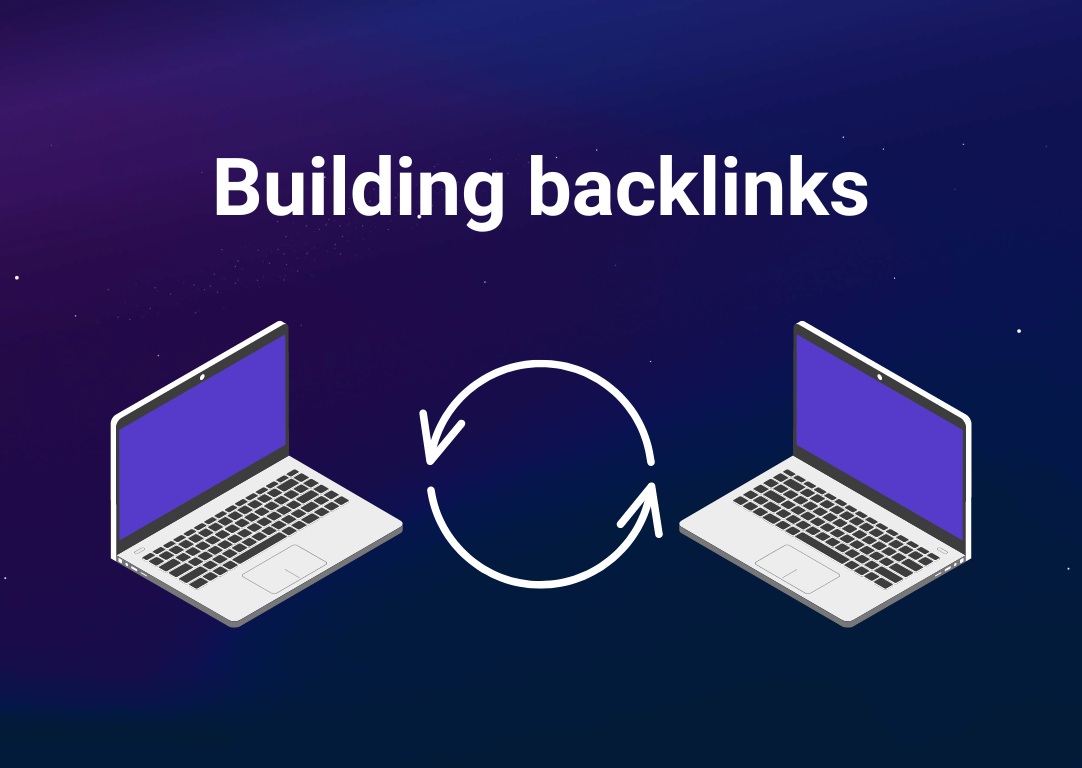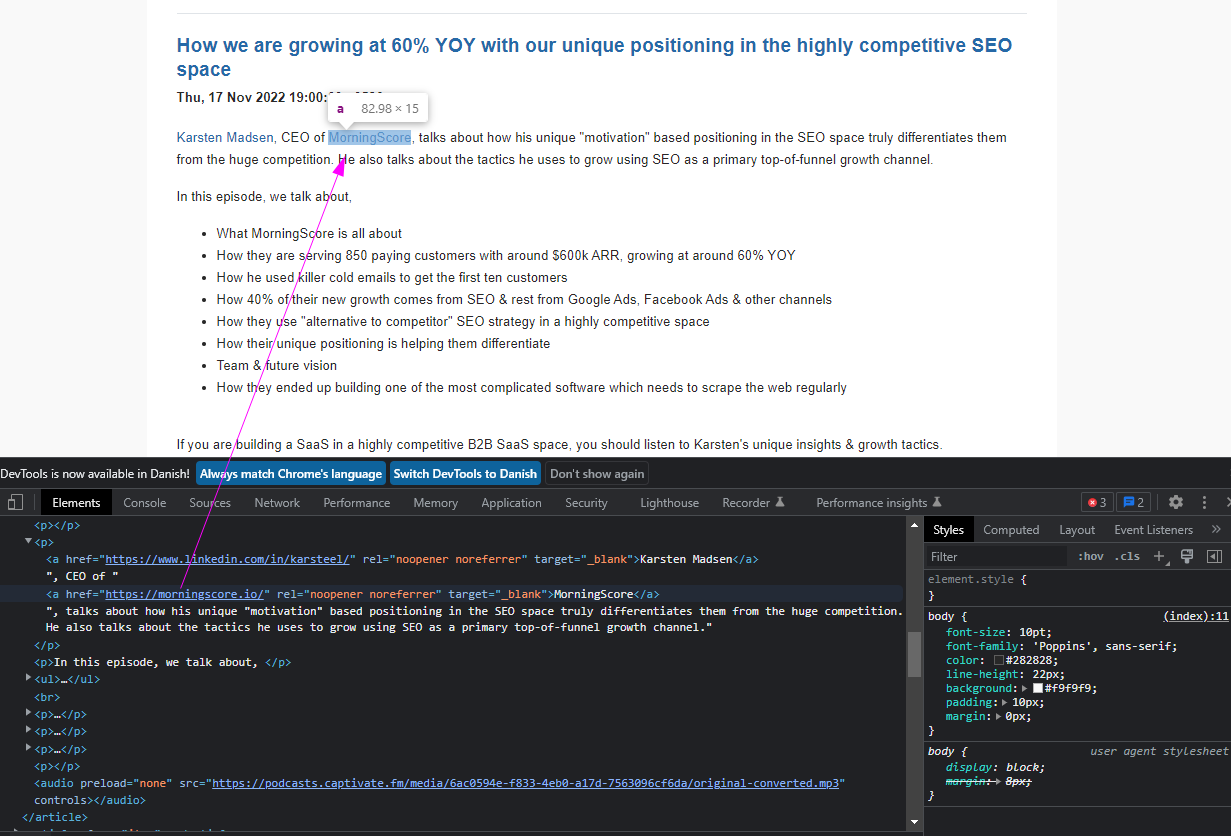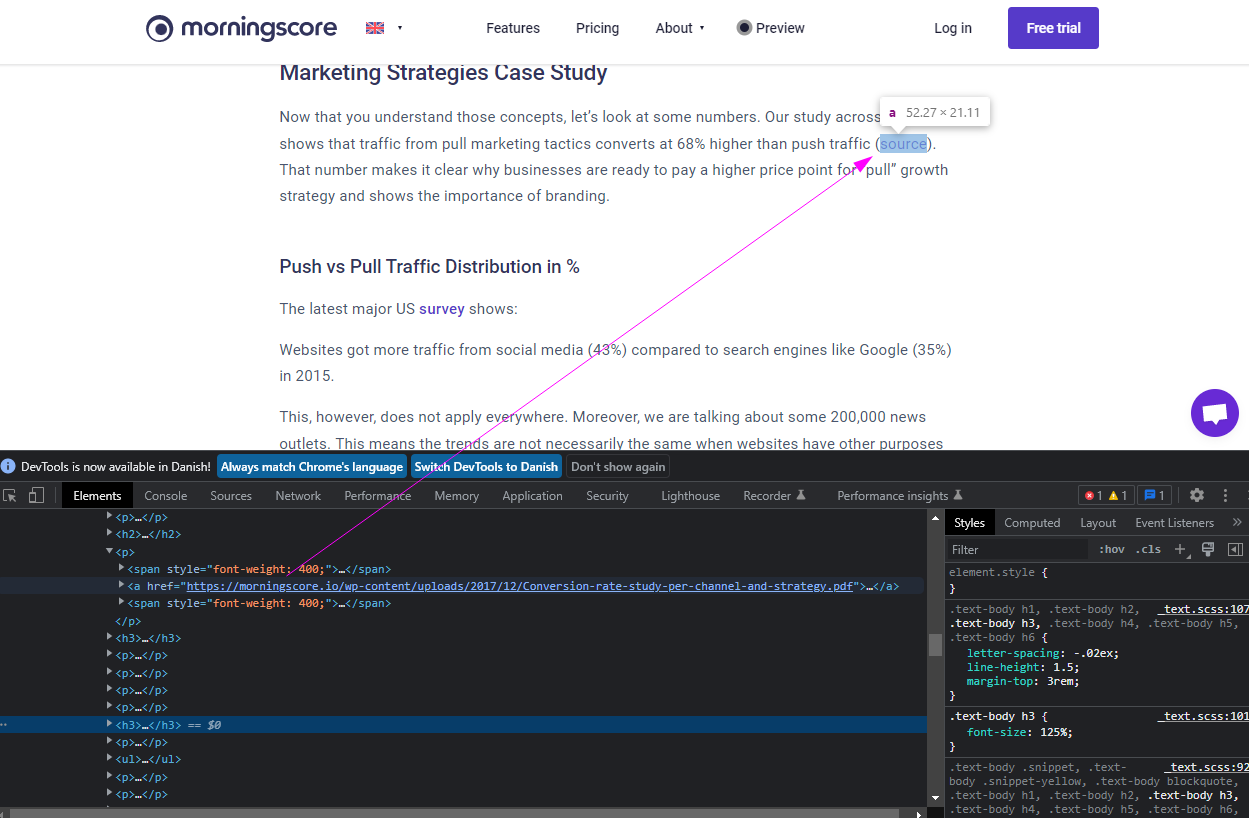Have you been looking for an easy English guide to understanding how backlinks work? Good. Then you’ve come to the right place.
In this post, you’ll get answers to some of the most common questions about backlinks – without any marketing jargon or fancy words.
At Morningscore, we often hear questions like:
- What are backlinks?
- How do backlinks work?
- What is the importance of backlinks for my website?
- … and what do they mean for my business?
- Why are backlinks important at all?

What are backlinks?
The term “backlink” refers to a link pointing back to your website from somewhere other than your own website. High-quality backlinks are one of the most important factors in SEO. Poor quality backlinks – such as spam links – have little or no value.
The term comes from English and is also known as “inbound links”, as it refers to a link pointing to your website.
Conversely, the links that go out from your website are called “outbound links”. Thus, by their very nature, your backlinks act as outbound links for other websites, just as other people’s backlinks to your website act as outbound links for you. The overall common term is “hyperlinks” – or colloquially just “links”.
In the picture below you can see a backlink we got from captivate.fm. That link is an outbound link for Amino and an inbound link for Morningscore because it points to one of our blog posts.
How do backlinks work?
Backlinks between websites act as important signals to search engines. When one website links to another, Google sees it as a stamp of approval for the website being linked to. The more backlinks you get from websites with high authority, the better your website will look in Google’s eyes.
A backlink is a small piece of code that links one landing page to another, creating a digital shortcut on the internet.
In some cases, you will be able to see the URL of the landing page being linked to. In other cases, the address is invisibly hidden behind some text or an image, called “anchor text” and “anchor image” respectively.
What is an anchor text?
As we have already discussed, an anchor text is the clickable part of a text that covers a link to another page on the Internet. Anchor texts play a role in search engines’ interpretation of the content and relevance of the page linked to – so it is not unimportant what the anchor text is.
For example, putting a link to the front page of the Morningscore website behind a generic text like “read more here” is not very beneficial for SEO. It is better to define the content of the page with an anchor text like “read more about Morningscore’s SEO tool“.
The image below illustrates a link included in a blog post about Morningscore’s case study on push vs. pull marketing. Here, the anchor text is the word “source”, which covers a shortcut to a PDF file. In the image you can also see what the link looks like when looking at the source code behind the blog post.

Mind you, you don’t have to dive into the code to make backlinks, because it can be done with just a few clicks in all major CMSs. “CMS” is the common acronym for Content Management System, and it covers the types of tools most people use to set up and edit the content on a website.
You can always tell the link function by the little icon that looks like three links in a chain. The button is usually accompanied by a function to remove links, which is typically found behind the icon illustrating the disappearance of the middle link in the chain. In WordPress, the world’s most widely used CMS, it looks like the image below.

How do I get backlinks?
There are several strategies you can use to get backlinks organically. Basically, it’s all a matter of creating quality content and distributing it in a way that others will notice and choose to redistribute it. Every time your content is shared on social media or via a backlink from another relevant website, your credibility increases.
How to build backlinks yourself
If your business has been around for a while, chances are someone has mentioned you in a context where a link would be relevant. You can easily find out if this is the case if you do a Google search like the one we’ve done in the image below.
With the command intext: “company” -inurl: “domain”, Google returns a list of pages outside your own domain that have mentioned your company. Review the results and then try to contact the sites that have made the most relevant mentions – and ask them to backlink to your website.

You can also build some easy and relevant backlinks by making sure your website is linked to your company’s social media profiles and from relevant partners.
Why are backlinks important?
Links are important because they play a vital role in building the internet and in the way search engines work: it’s backlinks that give search engines the context they need to identify the best content.
Backlinks from reputable sources are simply used as an indicator that your website contains valuable information. The more backlinks you have, the more credible you are in Google’s eyes – and the higher your rankings.
That’s why backlinks are so important.
Backlinks are digital recommendations
Imagine you go to a library to find the best book on fly fishing. The librarian shows you to the outdoor hobby section on the third floor and you start skimming the shelves for relevant reading material. It turns out there are at least 50 books on fly fishing. How do you find the best one?
Check out the recommendations. Ask the librarian for advice on which book is best. Ask friends and acquaintances who know about fly fishing. Read the recommendations on the book covers.
Then check the references in the most interesting books and find out which sources are referred to most often. There you have the answer: the best book on fly fishing is the one that most often gets good recommendations from other good sources.
The history of backlinks
When you search for something on Google and the search engine returns a list of search results, the order is anything but random. It’s determined by Google’s algorithm, which has been refined over the years to deliver the best content on the web to search engine users.
In the early days of search engines, the frequency and density of keywords was the only indicator used to assess the relevance of a landing page. However, someone soon figured out how to exploit this, and a practice popularly known as “keyword stuffing” developed. This is the practice of stuffing your page with a lot of popular keywords to make it attractive to search engines, without necessarily reflecting good-quality content.
Today, the algorithm consists of more than 200 different factors, and backlinks play an important role in more than one sense. The quality and number of links is now an important factor because it has been shown in practice that ranking cannot be based solely on content that is relatively easy to manipulate.
This is why Google’s algorithm is now designed so that trusted recommendations – links from trusted websites – play a key role in the way the internet works. This construction is based more on recommendations, as Larry Page and Sergey Brin, Google’s founders described back in 1998 in a scientific paper entitled The PageRank Citation Ranking: Bringing Order to The Web.
Manipulating backlinks
As with keyword stuffing in the past, there were of course those who quickly found a way to manipulate their landing pages and websites so that they looked good in the eyes of search engines, even if the quality was not necessarily good.
Indeed, in the beginning, the number of links was by itself a ranking factor, and some website owners started generating thousands of links to their landing pages in a more or less automatic way. Generic spam comments became a widespread practice in order to achieve a high number of backlinks.
Google’s goal has always been to provide quality content to those who use the search engine. Therefore, they had to find a way to secure search results against backlink manipulation, and the solution was to introduce the concept of “nofollow” links.
What types of backlinks are there?
From a search engine perspective, there are basically two types of links: “dofollow” and “nofollow”.
“dofollow” links
By default, all links are “dofollow”, which means that search engines take them into account when evaluating a website’s overall link profile. Every link on the internet thus acts as a signal to search engines to recommend the content it links to – unless the link contains a caveat in the form of a “nofollow” link.
“nofollow links
There can be many good reasons for being cautious with the signals you send to search engines when you create a link. For example, you may be linking to a website that you consider irrelevant or unreliable, which could in theory be damaging.
In such cases, you can use the “nofollow” tag to let Google know that your website should not be taken into account when evaluating the content of the website you are linking to.
If you want to actively change a link on your website to be nofollow, the easiest way to do this in most CMSs is to use a plugin that allows you to change a link to be “nofollow” with a single click. You can also always do it manually by adding the rel=”nofollow” attribute directly in the source code. Whichever option you choose, you ensure that search engines do not attribute value to the website the link ends up on.
Which backlinks are best?
When working with backlinks, always focus on links that improve the content of the page you are linking from. These could be studies, tests, or other types of sources that specifically support or expand on the topic of your content.
The best backlinks are “dofollow” backlinks from reputable websites where the link is a natural part of the content. Although it’s best to get high-quality links, you can get great results with medium-quality links – but make sure you avoid links that are outright poor quality.
As we’ve already discussed, anchor texts are also an important factor when working with SEO. However, this doesn’t mean that you can trick the search engine into interpreting a link as relevant just because it has a certain anchor text. The algorithm is clever enough to be able to decode these kinds of tricks.
When working with SEO, it is always important to avoid linking to spam pages or other pages that are irrelevant to your website. These types of bad backlinks can do more harm than good and dilute your credibility with both users and search engines.
How to remove bad backlinks
If you get backlinks from websites you don’t want to be associated with, you can reject them so that Google disregards them in its overall assessment of your website.
However, Google’s algorithm is now so good at identifying bad links automatically that in the vast majority of cases, you won’t need to do anything actively to avoid damage from these types of links. However, if this does happen to your website, you can follow this guide to learn how to remove an unwanted backlink.
Your website won’t be hugely affected by a few bad backlinks, but make sure it doesn’t get out of hand. Quality is always better than quantity, and this is true both when it comes to external links to other websites and when it comes to internal links that connect the content on your own landing pages.
What are internal backlinks?
An internal link is a hyperlink that goes from one of your landing pages to another page on your website. This means that the link connects one web address – also known as a URL – to another web address on the same domain. And a domain is the part of the internet that you take ownership of by buying a domain name. For example, Morningscore owns the domain name www.morningscore.io, which you are currently visiting to read a blog post.
In principle, you can own a domain without having a website on it – just like you can own a building plot without building a house on it.
Why are internal links important?
Internal links on a website are important because they help search engines discover, index, and understand the content of each page on your website.
If you create a new landing page that is not part of your sitemap, the search engines have no way of knowing that the page exists – unless you make the page visible through backlinks.
Usually, the front page of a website is the strongest page because it often gets the most visitors and has the most inbound links. In most cases, linking to other pages on your site from the front page will increase their value, because search engines take this as a signal that the strong front page gives the content of the pages it links to a higher profile.
By the way, there is no doubt that the number of internal links is an important factor when working with SEO. Google itself has stated that the search engine interprets a high number of internal links to a landing page as a signal that this particular landing page is particularly valuable. But irrelevant links are a drag, so always remember to focus on quality.
How to ensure the best link structure
It matters how the internal structure looks when search engines crawl your website and the links that crisscross the different pages.
You can ensure good link structure by thinking of your whole website as a pyramid, with the most important page at the top, some other important pages at the level just below, and so on.
Most often, the front page is at the top of the pyramid. Below that, you’ll find overarching sections such as a product page, a blog, and an “about” page, and then at the level further down the pyramid, each section can be broken down further. It is important that your internal links reflect the logic of the structure of the sections and their subdivisions.
For example, imagine that your website is about motor vehicles. In that case, it would be natural to have landing pages for cars, motorcycles, Toyota, Audi, Suzuki, and Harley Davidson.
The best structure, in this case, would be to create one section for cars and one for motorcycles and then create subpages under each section for the brands that belong. This will ensure that the structure makes sense to both users and search engines, which can easily identify which page is specifically about Harley Davidson motorcycles, for example.
Are backlinks still important?
Yes, backlinks are still a crucial factor for anyone working in search engine optimization. Since Google and the other search engines use backlinks to understand and assess the quality of the content on a website and the context in which it sits, they remain an essential part of how the internet and search engines work. At the same time, of course, it’s worth remembering that digitization and the technological advances that set the framework for all digital marketing work are constantly evolving. New updates are introduced and new algorithms are launched that can change the rules of the game from day to day, so as a website owner it’s a good idea to keep your finger on the pulse so you can react to significant changes that could affect your website and your rankings in search results. For now, however, you can assume that your good backlinks will retain their value for a while. Maybe forever.
Besides, to keep the overview, monitor, and act on lost links you need a reliable backlink checker tool.

